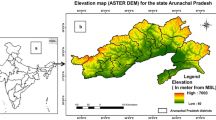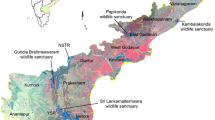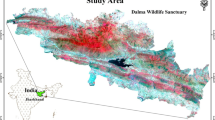Abstract
This is the first of its kind work on the assessment of forest burnt area and fire hotspots of Myanmar using Landsat OLI data and spatial statistics tool. Burnt area analysis indicates 15.2% of vegetation area was affected by fires in 2017. Analysis of burnt area at state level indicates Kayah affected by more fires in 2017. Of the total vegetation fire occurrences from 2003 to 2017 about 44.7% were observed in the forested landscapes of Myanmar. The emerging hotspot analysis had shown the highest spatial extent of persistent hotspots followed by oscillating hotspots. Forest fire hotspots are mainly found in the states of Kayah, Shan, Bago, Nayi Pyi Taw, Magway, Mandalay, Chin, and Kayin. Overall earth observations based on 2003 to 2017 fire occurrences indicate a declining trend of fires in Myanmar. A comparison of the fire occurrences recorded by MODIS and VIIRS indicates that VIIRS is capable of detecting a greater number of fire incidences. The findings of the study would support in assessing the impact of fires on forest, its structure, composition, function, and provide valuable input for nationwide forest fire management.


Similar content being viewed by others
References
Arima, E. Y., et al. (2005). Loggers and forest fragmentation: Behavioral models of road-building in the Amazon basin. Annals of the Association of American Geographers,95(3), 525–541.
Bennett, M. (2010). Reducing fire risk on your forest property (Vol. 618). Corvallis: Oregon State University Extension Service.
Biswas, S., et al. (2015). Factors controlling vegetation fires in protected and non-protected areas of Myanmar. PLoS ONE,10(4), e0124346.
Chuvieco, E., et al. (2003). Combining NDVI and surface temperature for the estimation of live fuel moisture content in forest fire danger rating. Remote Sensing of Environment,92(3), 322–331.
Cochrane, M. A., & Laurance, W. F. (2002). Fire as a large-scale edge effect in Amazonian forests. Journal of Tropical Ecology,18(3), 311–325.
Cochrane, M. A., et al. (1999). Positive feedbacks in the fire dynamic of closed canopy tropical forests. Science,284(5421), 1832–1835.
FAO. (2006). Global forest resource assessment 2005 progress towards sustainable forest management. Rome: UN Food and Agriculture Organization.
Fuller, D. O., Jessup, T. C., & Salim, A. (2004). Loss of forest cover in Kalimantan, Indonesia, since the 1997–1998 El Nino. Conservation Biology,18(1), 249–254.
Getis, A., & Ord, J. K. (1992). The analysis of spatial association by use of distance statistics. Geographical analysis,24(3), 189–206.
Gupta, S., et al. (2018). Forest fire burnt area assessment in the biodiversity rich regions using geospatial technology: Uttarakhand Forest Fire event 2016. Journal of the Indian Society of Remote Sensing,46(6), 945–955.
Harmon, M. (1982). Fire history of the westernmost portion of Great Smoky Mountains National Park. Bulletin of the Torrey Botanical Club,109, 74–79.
IPCC. (2007). Fourth assessment report of the intergovernmental panel on climate change. Cambridge: Cambridge University Press.
Mann, H. B. (1945). Nonparametric tests against trend. Econometrica: Journal of the Econometric Society,13, 245–259.
McKenzie, Donald, et al. (2004). Climatic change, wildfire, and conservation. Conservation Biology,18(4), 890–902.
Miller, Jay D., & Thode, Andrea E. (2007). Quantifying burn severity in a heterogeneous landscape with a relative version of the delta Normalized Burn Ratio (dNBR). Remote Sensing of Environment,109(1), 66–80.
Nasi, R., et al. (2002). Forest fire and biological diversity. UNASYLVA-FAO,53, 36–40.
Nepstad, D., et al. (1999). Large-scale impoverishment of Amazonian forests by logging and fire. Nature,398(6727), 505.
Nepstad, D., et al. (2001). Road paving, fire regime feedbacks, and the future of Amazon forests. Forest Ecology and Management,154(3), 395–407.
Reddy, C. S., Unnikrishnan, A., Asra, M., Manikandan, T. M., & Jaishanker, R. (2019). Spatial conservation prioritisation of threatened forest ecosystems in Myanmar. Journal of Indian Society of Remote Sensing,47(10), 1737–1749.
Reddy, C. S., et al. (2014). Threat evaluation for biodiversity conservation of forest ecosystems using geospatial techniques: A case study of Odisha, India. Ecological Engineering,69, 287–303.
Reddy, C. S., et al. (2017). Nationwide assessment of forest burnt area in India using Resourcesat-2 AWiFS data. Current Science,112(7), 1521–1532.
Rothermel, R. C. (1991). Predicting behavior and size of crown fires in the Northern Rocky Mountains. Res. Pap. INT-438. Ogden, UT: US Department of Agriculture, Forest Service, Intermountain Research Station. 46 p. 438.
Roy, D. P., Boschetti, L., & Trigg, S. N. (2006). Remote sensing of fire severity: Assessing the performance of the normalized burn ratio. IEEE Geoscience and Remote Sensing Letters,3(1), 112–116.
Rudel, T. K., et al. (2005). Forest transitions: Towards a global understanding of land use change. Global Environmental Change,15(1), 23–31.
Vadrevu, K. P., & Justice, C. O. (2011). Vegetation fires in the Asian region: Satellite observational needs and priorities. Global Environmental Research,15(1), 65–76.
Zhu, Y, Newsam, S. (2016). Spatio-temporal sentiment hotspot detection using geotagged photos. In Proceedings of the 24th ACM SIGSPATIAL international conference on advances in geographic information systems. ACM.
Acknowledgements
The present work has been carried out as part of ISRO’s National Carbon Project. We thank ISRO-DOS Geosphere Biosphere Programme for financial support. We are grateful to Director, NRSC, Deputy Director, RSA, NRSC, and Group Director, NRSC, for suggestions and encouragement. We are thankful to NASA, ESA, and USGS for providing free open access data.
Author information
Authors and Affiliations
Corresponding author
Additional information
Publisher's Note
Springer Nature remains neutral with regard to jurisdictional claims in published maps and institutional affiliations.
About this article
Cite this article
Unnikrishnan, A., Reddy, C.S. Characterizing Distribution of Forest Fires in Myanmar Using Earth Observations and Spatial Statistics Tool. J Indian Soc Remote Sens 48, 227–234 (2020). https://doi.org/10.1007/s12524-019-01072-9
Received:
Accepted:
Published:
Issue Date:
DOI: https://doi.org/10.1007/s12524-019-01072-9




